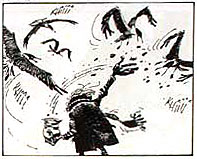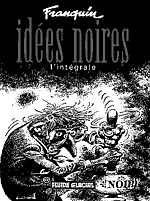>> Beyond Borders: Mondo Loco
>> Beyond Borders: Every Picture Tells A Story
More...

That which you don't see, that which you can only guess at, can sometimes be far more terrifying than that which you can see with your own eyes.
The menacing symbolism of darkness has been used profusely in the comics medium. From the noir abstractions of Frank Miller's SIN CITY, to the black and white polar expressionism of Sampayo and Muñoz's ALACK SINNER, the use of heavy inks is a common tool to kick the reader's mood at the creator's will. But no artist has taken the use of the dark as a tool to the extremes of André Franquin in IDÉES NOIRES, where the pitch black art sets the tone for the book even before you read it. Never have the words 'black comedy' been better applied than in this outright nasty and uneasy book, the masterpiece of one of Europe's most notorious creators.
For the English reader, the name Franquin probably won't ring many bells. But for the European bande desinée connoisseur, Franquin is truly a legend, who stands alongside TINTIN creator Hergé and ASTERIX co-creator René Goscinny as one of Europe's most successful European comic creator.
 André Franquin was born in Brussels, Belgium, in 1924, and started work in the comics industry at the age of twenty. He joined an animation studio with fellow comics legends Morris, the creator of cowboy Lucky Luke, and Peyo, the creator of The Smurfs, but he soon left the studio to start working on the character that would make his name; Spirou.
André Franquin was born in Brussels, Belgium, in 1924, and started work in the comics industry at the age of twenty. He joined an animation studio with fellow comics legends Morris, the creator of cowboy Lucky Luke, and Peyo, the creator of The Smurfs, but he soon left the studio to start working on the character that would make his name; Spirou.
Spirou, a lift attendant at the Moustique Hotel, was originally created by the artist Rob-Vel in the late thirties, as a direct competitor to Hergé's Tintin. The SPIROU magazine became a huge success thanks to the work of another comic legend, Jijé, but it was not until Franquin's arrival at the title that it really reached its full potential. In Franquin's hands, SPIROU spiralled off down the road of mad ideas.
Aimed at children, but easily enjoyed by older audiences, the SPIROU comics are all-ages adventure strips that work like a well-oiled machine. Fast paced, reckless and innovative, Franquin created tons of characters for the series, including the mascot Marsupilami, the evil übervillain Zorglub - arguably one of the funniest characters ever created - and the prototype of the mad professor, the Baron de Champignac. Franquin's SPIROU remains a true masterpiece, which is a little scary when you consider that it's one of the first comics he ever worked on. What's even scarier is that this wasn't to be his only great work. He was to follow it up with some of the finest comedy books ever to emerge from Europe.
In 1955, Franquin created MODESTE ET POMPON for TINTIN magazine, a comedy series that ran until 1959 - but this wasn't his next masterpiece. That came in 1957, with the arrival in the pages of the same magazine of GASTON LAGAFFE. Sometimes defined as simple slapstick, LAGAFFE, like the Marx Brothers, escapes such simple definition. Born as one panel, black and white comedy gags, a coloured version soon appeared, and full-length stories soon followed. When the series finally ended in 1997, Franquin had created fifteen volumes of surrealistic, catastrophe-ridden humour.

LAGAFFE is simply one of the finest comedies to ever see print on comics form. Set in the main offices of TINTIN magazine, it portrays the misadventures of Gaston, a do-it-all worker in the offices, always on the verge of wrecking havoc over his colleagues and co-workers. Sadly, with the exception of a few stories translated as GOMER GOOF by Fantagraphics, the English-speaking audience hasn't been given the opportunity to appreciate this work.
With LAGAFFE fast becoming a best seller, Franquin could only try to reach new heights. He was already regarded as the pre-eminent master of comedy in Franco-Belgian comics with only two important works under his belt. His best was yet to come. Another comedy. Maybe the blackest, cruellest comedy in all comic history. IDÉES NOIRES. Black Ideas.
In 1977, Franquin started work on LE TROMBONE ILLUSTRÉ, a more adult version of TINTIN magazine. While working on the magazine, he achieved the remarkable design feat of changing the magazine's logo every issue, and in 1981, he developed a new art style for a series of one-page gags, which would later move to another magazine, FLUIDE GLACIEL, when LE TROMBONE closed.
These 'Idées Noires' looked, at first sight, like regular Franquin panels, but with a remarkable difference; the inking covered the figures, creating a sort of "negative" effect. The usual detail on Franquin's figure work was still there, but there was a distinctive pitch-black inking over all the panels. And the plots were not the usual Franquin themes. They were thought provoking, darker, more violent, extremely bitter and terribly funny. Reading IDÉES NOIRES is like watching a clown getting run down while telling a particularly unfunny joke.
 The themes range from hunting accidents to the perils of rampant capitalism to extremely gruesome anecdotage. Perhaps the most shocking aspect of the comic, though, is that it was the work of a cartoonist renowned for his children's work. Yet here Franquin was telling jokes about children being eaten by sharks, about post-apocalyptic worlds where only the flies survive, or about chicken factory workers getting plucked and gutted by their own machinery.
The themes range from hunting accidents to the perils of rampant capitalism to extremely gruesome anecdotage. Perhaps the most shocking aspect of the comic, though, is that it was the work of a cartoonist renowned for his children's work. Yet here Franquin was telling jokes about children being eaten by sharks, about post-apocalyptic worlds where only the flies survive, or about chicken factory workers getting plucked and gutted by their own machinery.
This isn't gross-out humour for the sake of it, though, as genuine social concerns inform most of Franquin's work, most notably environmentalism, civil rights and the arms race. Reading the strips often leaves the audience with quite an uneasy feeling, since we're laughing at extreme atrocities, and it's often the absurdities of the real world around us that provide the actual punchline.
One particularly striking example is a strip that was used as an ad for Amnesty International. The strip brings back Gaston Lagaffe, portrayed with his usual careless attitude, reading about the world's dramas. He's obviously unruffled, since these events don't affect him. Franquin then changes the pace, placing Lagaffe at the heart of these atrocities. Torture, execution, rape, political oppression... there's no need to lay it out in detail, so Franquin leaves the action thankfully obscure. Yet the meaning is clear, and one doesn't need to understand French to understand the strip.
Franquin died in 1996, and with him died the last of the great masters of Franco-Belgian comics. Sadly, most of his work is either unreleased or out of print in English, but many of his strips can be found online.

This article is Ideological Freeware. The author grants permission for its reproduction and redistribution by private individuals on condition that the author and source of the article are clearly shown, no charge is made, and the whole article is reproduced intact, including this notice.


